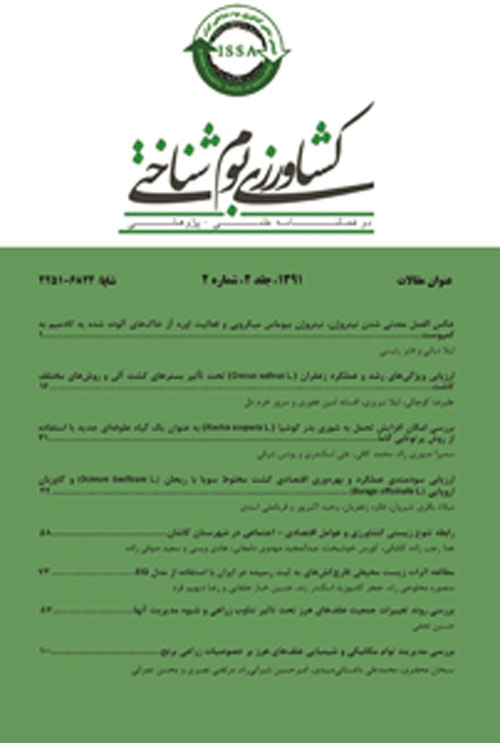Effect of plant density, height of harvest and consumption of nitrogen fertilizer after the first cutting on morpho-physiological characteristics and yield of Kochia
Author(s):
Abstract:
Introduction
Because Iran is in an arid and semi-arid area¡ lack of water is considered as a serious crisis in the country; so using agronomic techniques such as irrigation¡ use of low quality water resources (brackish and saline) and the use of dry-friendly herbs and halophytic herbs is of great importance in agricultural production. Deficit irrigation is an optimal solution for agricultural production whereby the removal of excess irrigation and reduction in water use at every turn has no negative effect on net profit but increases water use efficiency (Sohrabi et al.¡ 2006). Currently¡ an alternative crop resistant to drought compared with conventional forage plants has been kochia whose rapid deployment in the soil¡ in addition to creating a short lived protective cover¡ can be used as an alternative forage especially in areas that are confronted with lack of forage production (Jami Ahmadi et al.¡ 2004). Kochia is a drought resistant annual plant and can be a valuable source of forage in ecosystems under drought conditions. Its rapid growth of kochia and drought resistance shows that this plant has a high potential for designation as an important forage crop in arid and semi-arid areas (Jami Ahmadi and Kafi¡ 2007).Materials And Methods
In order to investigate the effect of plant density¡ height of harvest and consumption of nitrogen fertilizer on yield of dry matter and some agronomic traits of Kochia¡ an experiment was conducted in a factorial arrangement based on a randomized complete block design with three replications in spring and summer of 2011 in a research field at Neishabour city. The treatments consisted of plant density at three levels (20¡ 30 and 40 plants in 1 m2)¡ height of harvest at two levels (10 and 20 cm from level of soil) and nitrogen fertilizer at two levels (consumption of 150 kg ha-1 Urea after the first cutting and non consumption nitrogen fertilizer).Results And Discussion
The results indicated that the effect of plant density was not significant on the leaf dry weight and the ratio of the leaf dry weight to stem in the first and second cutting¡ while its effect on the yield¡ stem dry weight and the leaf area index in the first and second cuttings was significant; also¡ by increasing the plant density¡ these traits increased significantly. The effect of the height of harvest on studied traits¡ also the consumption of Urea after the first cutting on the yield of dry matter¡ stem dry weight and the leaf area index in the second cutting was not significant¡ but its effect on leaf dry weight and the ratio of the leaf dry weight to stem in the second cutting was significant.Conclusion
Generally¡ it seems that the plant density of 30 plants per m2¡ the height of harvest of 20 cm from level of soil and the consumption nitrogen fertilizer after harvest of the first cutting are effective factors to obtain desirable yield and quality in produced forage of Kochia. Keywords:
Halophyte , Forage , Leaf area , Dry weight
Language:
Persian
Published:
Journal of Agroecology, Volume:6 Issue: 1, 2016
Page:
227
magiran.com/p1586564
دانلود و مطالعه متن این مقاله با یکی از روشهای زیر امکان پذیر است:
اشتراک شخصی
با عضویت و پرداخت آنلاین حق اشتراک یکساله به مبلغ 1,390,000ريال میتوانید 70 عنوان مطلب دانلود کنید!
اشتراک سازمانی
به کتابخانه دانشگاه یا محل کار خود پیشنهاد کنید تا اشتراک سازمانی این پایگاه را برای دسترسی نامحدود همه کاربران به متن مطالب تهیه نمایند!
توجه!
- حق عضویت دریافتی صرف حمایت از نشریات عضو و نگهداری، تکمیل و توسعه مگیران میشود.
- پرداخت حق اشتراک و دانلود مقالات اجازه بازنشر آن در سایر رسانههای چاپی و دیجیتال را به کاربر نمیدهد.
دسترسی سراسری کاربران دانشگاه پیام نور!
اعضای هیئت علمی و دانشجویان دانشگاه پیام نور در سراسر کشور، در صورت ثبت نام با ایمیل دانشگاهی، تا پایان فروردین ماه 1403 به مقالات سایت دسترسی خواهند داشت!
In order to view content subscription is required
Personal subscription
Subscribe magiran.com for 70 € euros via PayPal and download 70 articles during a year.
Organization subscription
Please contact us to subscribe your university or library for unlimited access!



